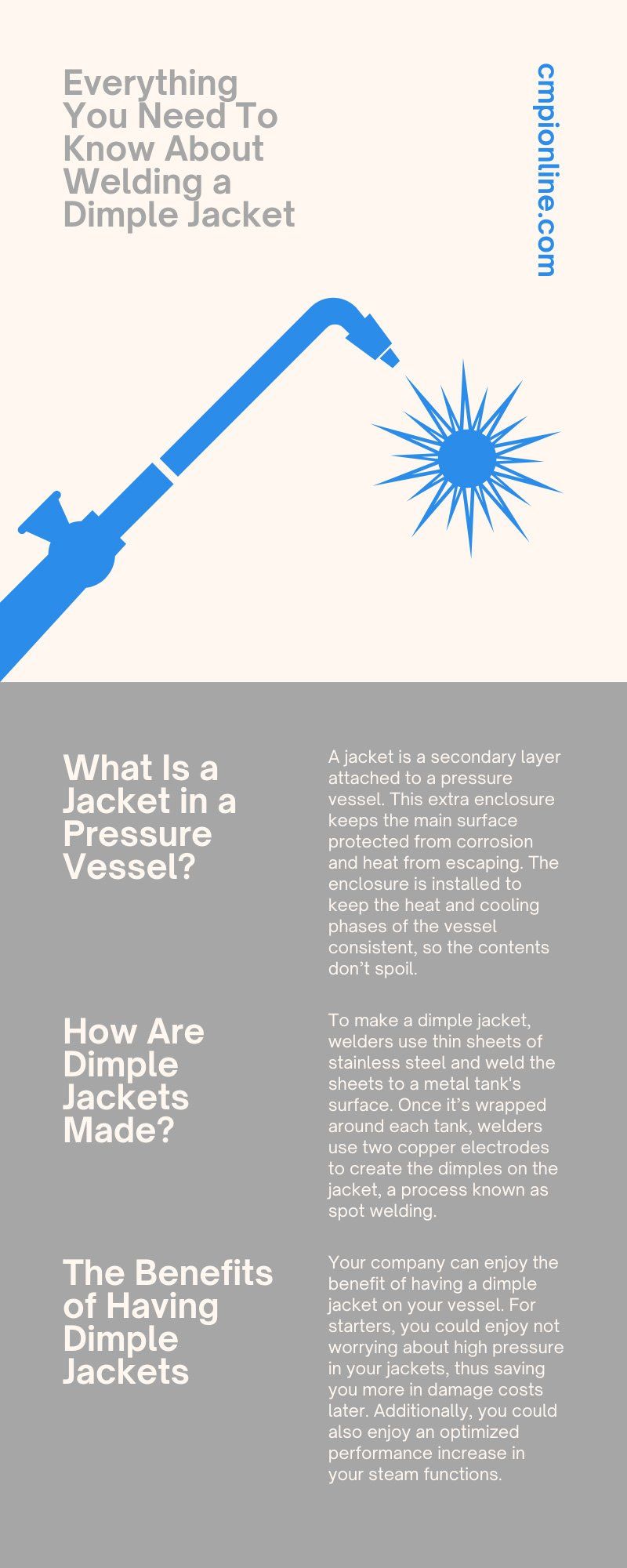Everything You Need To Know About Welding a Dimple Jacket

Every industry working with pressurized materials needs to ensure that the vessels these materials are in perform well and last a long time under uniform temperatures. The manufacturing industry requires full attention to how everything is processed.
Without proper vessels, these supplies could spoil, so companies utilize stainless steel jacketed vessels to keep these contaminants safe. Here is a guide filled with everything you need to know about welding a dimple jacket.
What Is a Jacket in a Pressure Vessel?
A jacket is a secondary layer attached to a pressure vessel. This extra enclosure keeps the main surface protected from corrosion and heat from escaping. The enclosure is installed to keep the heat and cooling phases of the vessel consistent, so the contents don’t spoil.
How Are Dimple Jackets Made?
To make a dimple jacket, welders use thin sheets of stainless steel and weld the sheets to a metal tank's surface. Once it’s wrapped around each tank, welders use two copper electrodes to create the dimples on the jacket, a process known as spot welding.
What Is Spot Welding?
Spot welding is the process of using two copper electrodes to create dimples in a vessel jacket. The procedure uses a charged electric current to create heat around low-carbon metals. Once the heat lands on the metal surface, the heat creates the weld.
Unlike other metals, copper is used in this welding process because it has a higher thermal conductivity and lower resistance to electricity. In retrospect, this means that heat is created in each workpiece instead of the electrodes.
The Most Common Applications of Jacket Vessels
There are other common usages of jacket vessels besides dimple jackets. Here is an overview of other everyday uses of jacket vessels.
Internal Coils
An internal coil is not a jacket, but an additive placed inside the vessel that attaches to the vessel's contents. Once the internal coil is attached to the vessel's materials, it provides thermal heat, like how the dimple jacket would heat the container's surface. The internal coil can be in one of two places: the container's base or the internal walls.
Half-Pipe Coil
The half-pipe coil is a partial jacket that wraps around the bottom of the container. This piping system either raises or lowers the temperature of the part or the entire body of the vessel. When the temperature fluctuates, this alters the path of the contents. If you have liquid in your containers, you could use either heat transfer or high-temperature functions for half-pipe coil jackets.
Signs Dimple Jacket Vessels are High-Quality
You can tell a dimple jacket vessel is high-quality based on the pattern spacing, structural welding, and material strength. Here are the telltale signs that a dimple jacket vessel is of high quality.
Structural Welding
Before filling your containers with fluids and other contents, you must ensure that the structure is sound. You can quickly check the welding structure's quality by inspecting the structural components, like the footers. Since the material is thin, you want to ensure that the parts are welded directly onto the structure. If you don’t weld the structure parts correctly, you could encounter problems with the heating and cooling phases.
Dimple Design
Your dimple design must be concise. Every dimple you make in your vessel’s stainless steel sheet. A proper dimple design must be two inches above and two inches to the left and right sides of each depression. When the depressions are welded closer together, the dimple jacket strength improves.
Material Strength
The material's strength can affect the jacket's strength. Without using the proper measures, you could risk creating weaker walls. The best measure you should use when creating thicker jackets is a 13-gauge, while a 14- or 16-gauge creates thinner walls.
Connection Placement
If you want to ensure that the fluid flows well, place the connecting parts on the right path. When connecting the heads of the connecting ports, they must be facing each dimple so that the fluid flows smoothly and toward the spout. The overall structural strength improves when the spout and connection parts are placed on precisely.
The Benefits of Having Dimple Jackets
Your company can enjoy the benefit of having a dimple jacket on your vessel. For starters, you could enjoy not worrying about high pressure in your jackets, thus saving you more in damage costs later. Additionally, you could also enjoy an optimized performance increase in your steam functions.
Some of the other benefits you and your company can look forward to include the following:
- Low media flow and better heat transfer.
- Liquid distribution is improving significantly.
When To Use a Dimple Jacket
A steam company can look forward to using dimple jackets for their vapor applications. Since there is a significant amount of pressure in these vessels, steam workers use the stainless steel dimple jackets to hold the heat in and improve the flow of content. If you use larger or smaller tanks, you may experience significantly lower costs on larger tanks due to not using conventional jackets.
The Industries That Use Dimple Jackets
Besides the steam and manufacturing industries, many other job fields utilize dimple jackets in their steel vessels. Here’s a quick list of the different career fields that use dimple jackets in their everyday:
- Healthcare
- Pharmaceutical
- Industrial
- Roofing companies
- Chemical plants
- Breweries and distilleries
Invest in High-Quality Dimple Jackets With CMPI
Investing in high-quality dimple jackets is possible. At Custom Manufacturing and Polishing, Inc., we promise always to deliver what you want most, no matter how challenging the concept art is. We’re dedicated to producing high-quality stainless steel sheets for you and your company to use on your vessels.
Your business deserves the best high-quality dimple jackets for your vessels. With your newfound knowledge of how to weld a dimple jacket for a vessel, it’s time to talk about your dream designs. Team up with CMPI to create dimple jackets —we’re precise with our spacing and depth. Contact us for more information on what we can do for you and your business. We can’t wait to chat with you!




